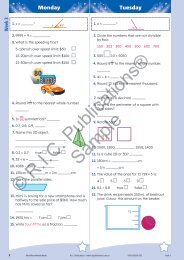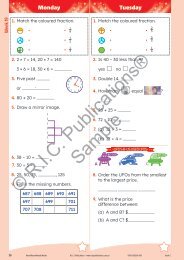PR-0552UK Primary Science - Book 2
Create successful ePaper yourself
Turn your PDF publications into a flip-book with our unique Google optimized e-Paper software.
Static electricity<br />
Magnetism and electricity ~ Activity 3<br />
Objective<br />
• explore the effects of static<br />
electricity<br />
Working scientifically<br />
• Questioning<br />
• Observing<br />
• Predicting<br />
• Investigating and experimenting<br />
• Recording and communicating<br />
Designing and making<br />
• Exploring<br />
Background information<br />
Electricity is always trying to move<br />
from one thing to another. If it cannot<br />
move for some reason, it is called<br />
static electricity. There are several<br />
ways that you can create static<br />
electricity, and see its effects.<br />
Note: These experiments are most<br />
successful if they are done on a dry<br />
day.<br />
Before the lesson<br />
Materials needed<br />
• Plastic pens, plastic combs, cloth, access to a wet area with tap, wool or woollen<br />
jumper or woollen scarf, balloons, paper, scissors, two magnets, nylon thread,<br />
sticky tape.<br />
Preparation<br />
Set up three stations with materials.<br />
Station 1: pens, cloth, small squares of paper.<br />
Station 2: combs, cloth, tap, sponges to clean up mess.<br />
Station 3: blown-up balloons, wool or woollen jumper.<br />
The lesson<br />
Stimulus<br />
• Ask the pupils if they have ever ‘zapped’ anyone by accident. Where has this<br />
happened? What shoes were they wearing? What covering did the floor have?<br />
(Usually rubbing rubber shoes along a carpet will create static electricity. Some<br />
pupils may suggest getting in and out of a car as well.)<br />
What to do<br />
• Organise the pupils into groups. Pupils go to each station and use the materials<br />
available to test if they can create electricity.<br />
• Pupils move to the next station and so on.<br />
• Pupils record their findings on the worksheet.<br />
• Explain to the class that electricity is always trying to move from one thing to<br />
another. When it cannot move for some reason, it is called static electricity.<br />
• Either in groups or as a whole-class demonstration, follow the steps in Question<br />
2.<br />
Note: The balloons should be hanging at the same height. Tie the balloons 2.5<br />
centimetres apart.<br />
• Rub the balloons together with a woollen scarf or jumper. What happens?<br />
Pupils draw the results on the worksheet.<br />
After the lesson<br />
Viewing Sample<br />
Answers<br />
1. (a) The pieces of paper are attracted to the pen.<br />
(b) The stream of water moves towards the comb.<br />
(c) The person’s hair lifts towards the balloon.<br />
2. (a) The balloons pull apart.<br />
(b) Teacher check<br />
Additional activities<br />
• Give the pupils a table for them to place in their books. The pupils record<br />
whenever they are affected by static electricity. They describe the events and<br />
the materials involved.<br />
Display ideas<br />
• If available, use a digital camera to take photographs of the pupils completing the<br />
experiments. Display the photographs under the heading ‘Static electricity’.<br />
66 <strong>PR</strong>IMARY SCIENCE ~ Prim-Ed Publishing ~ www.prim-ed.com


















